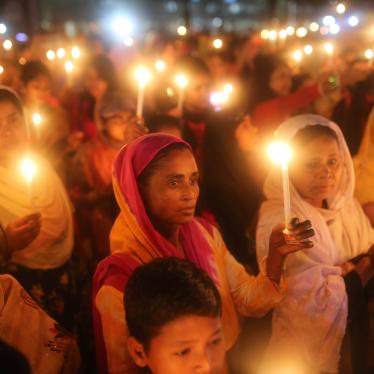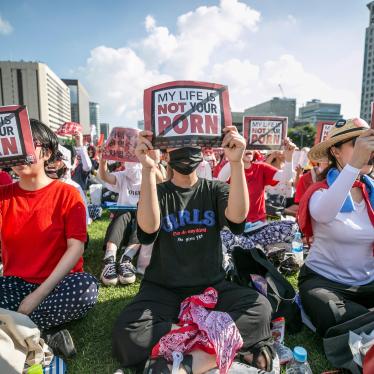Human Rights Watch documented the use of two types of ground-launched cluster munitions in multiple locations in Azerbaijan and Nagorno-Karabakh during the armed conflict that began on September 27 and concluded on November 10 with a ceasefire. Both Armenian and Azerbaijani forces used cluster munitions during the conflict. The cluster munitions attacks caused civilian casualties, both at the time of attack and from submunitions that failed to detonate at the time of attack.
Cluster munitions have been banned because of their widespread indiscriminate effects and long-lasting danger from their remnants. The 2008 Convention on Cluster Munitions, ratified by 110 countries, comprehensively prohibits cluster munitions and requires clearance of cluster munition remnants and assistance to victims of the weapons. Neither Armenia nor Azerbaijan is a party to the treaty. Both have stated in the past that they cannot accede to the ban convention until the dispute over Nagorno-Karabakh and other contested territories is resolved.
Methodology
Human Rights Watch documented the use of cluster munition rockets through its on-site investigations in Nagorno-Karabakh in October and November 2020 and Azerbaijan in November 2020. During these investigations, Human Rights Watch examined remnants of the cluster munition rockets and submunitions that exploded, as well as submunitions that failed to detonate at the time of attack. Its researchers consulted mine clearance operators on the ground in Nagorno-Karabakh, who plan to comprehensively survey and clear contaminated areas. Throughout its research, Human Rights Watch has sought to distinguish cluster munitions from other explosive weapons used in the conflict, some during the same attacks.
Human Rights Watch also reviewed videos and photographs taken by international journalists, disseminated by citizens over social media, or shared directly with its researchers. For example, one video recorded on October 4 captures a cluster munition attack on a street in Stepanakert.[1] Several photographs from the attack show unexploded submunitions.[2] A video posted by a Russian news outlet after the attack shows a man in unform handling unexploded submunitions and loading them into a container in a vehicle.[3]
Examples of Use of Cluster Munitions
This Briefing Note compiles research conducted by Human Rights Watch, but it does not seek to provide a complete accounting of the use of cluster munitions during the conflict. It has not been possible to investigate every reported or alleged cluster munition attack during this conflict.
Azerbaijani armed forces used cluster munitions in Nagorno-Karabakh on several occasions. This included attacks on September 27, October 3, and October 4 on Stepanakert, Nagorno-Karabakh’s administrative center, called Khankendi in Azerbaijan. Azerbaijan also used cluster munitions in attacks on Hadrut on October 3 and 4. It may have used cluster munitions in Martakert on October 14.
Armenian forces possess Smerch cluster munition rockets, but Nagorno-Karabakh forces do not. Therefore it is likely that Armenian forces used or supplied the cluster munition rockets to Nagorno-Karabakh forces who used them in attacks on Azerbaijan. There is evidence that Armenian and/or Nagorno-Karabakh forces used cluster munitions in Gizilhajili on October 3, Tapgaragoyunlu on October 23, Kebirli on October 24, Garayusifli on October 27, and Barda on October 28.
In addition to these attacks, other sources have reported the presence of remnants of cluster munitions and/or submunition duds elsewhere in the conflict area. For example, the Washington Post reported in December 2020 that deminers found and destroyed ten unexploded M095 submunitions, a type only possessed and used by Azerbaijan, from a residence in Kaghartsi Village, 16 miles east of Stepanakert.[4]
Types of Cluster Munitions
Cluster munitions can be fired from the ground by artillery, rockets, and mortars, or dropped by aircraft. They typically open in the air, dispersing multiple bomblets or submunitions over a wide area.
Two types of cluster munitions were used during the 2020 conflict, both delivered from the ground by rockets: LAR-160 rockets containing M095 submunitions and 9M55K Smerch rockets containing 9N235 submunitions. According to Cluster Munition Monitor, both types of cluster munition rockets were used previously in Nagorno-Karabakh in April 2016.
The Israeli-produced and exported LAR-160 cluster munition rockets have a minimum range of 12 kilometers and a maximum range of 45 kilometers. Each rocket delivers 104 M095 dual-purpose submunitions equipped with a self-destruct mechanism and a distinctive pink nylon stabilization ribbon. Each M095 submunition produces lethal metal pre-formed fragments and a jet of molten metal intended to destroy vehicles and materiel. Azerbaijan possesses LAR-160 cluster munition rockets that it received from Israel in 2008–2009, according to SIPRI, which reports that the Azerbaijani designations for the cluster munition rocket launchers are Dolu-1, Leysan, and Shimsek.[5] Armenia is not known to have received LAR-160 cluster munition rockets or any other weapons or ammunition from Israel.
A 300mm launch system delivers the 9M55K Smerch cluster munition rocket over a minimum range of 20 kilometers and a maximum range of 70 kilometers, according to its state-owned manufacturer Splav SPRA in Tula, Russia. Each rocket delivers 72 9N235 fragmentation submunitions, which are designed to self-destruct within two minutes of being ejected from the rocket. There is evidence that Armenia or Nagorno-Karabakh forces used Smerch cluster munition rockets in the conflict. Azerbaijan possesses Smerch cluster munition rockets, but Human Rights Watch does not have evidence that Azerbaijan used them during the conflict.
Responses to the Use of Cluster Munitions
Both Armenia and Azerbaijan denied using cluster munitions in the 2020 conflict but accused each other of using the weapons.
Armenia’s Ministry of Foreign Affairs told Human Rights Watch on November 27 that Armenia does not possess cluster munitions. A representative from Armenia’s Ministry of Defense on October 28 described allegations that Armenia used Smerch cluster munition rockets on the town of Barda as “groundless and false.”[6] At the United Nations in October 2020, Armenia called on states to condemn Azerbaijan for using banned cluster munitions.[7]
On October 16, 2020 at the United Nations, Azerbaijan accused Armenia of using prohibited cluster munitions.[8] In a BBC report aired on November 8, Azerbaijani President Ilham Ailyev denied that his government’s forces used cluster munitions during the conflict, describing the evidence provided as “fake news.”[9] On November 25, Azerbaijan told the Second Review Conference of the Convention on Cluster Munitions that there is no evidence to support allegations that its forces used cluster munitions in the conflict and condemned “in the strongest terms any use of cluster munitions by any actor under any circumstances.”[10]
Authorities from Nagorno-Karabakh did not confirm or deny use of cluster munitions during the conflict. Previously, in May 2017, a Nagorno-Karabakh representative stated that the “Republic Artsakh [the Nagorno-Karabakh Republic] does not possess cluster munitions and there has been no use, production, or transfer of cluster munitions on the territory of the Republic.”[11]
The use of cluster munitions in the Karabakh conflict has received worldwide media coverage, provoked public outcry, and been condemned by countries including Austria, Belgium, Canada, Costa Rica, Germany, Japan, Mexico, Netherlands, New Zealand, Switzerland, and the United Kingdom. The president of the Second Review Conference of the Convention on Cluster Munitions, Swiss Ambassador Félix Baumann, condemned the use of cluster munitions the conflict.[12] The United Nations and the Cluster Munition Coalition of non-governmental organizations, chaired by Human Rights Watch, has firmly condemned the use of cluster munitions by Armenia and Azerbaijan.[13]
Relevant Publications
For more detailed information, including eyewitness accounts, please see the following publications:
Human Rights Watch, “Azerbaijan: Cluster Munitions Used in Nagorno-Karabakh,” October 23, 2020, https://www.hrw.org/news/2020/10/23/azerbaijan-cluster-munitions-used-nagorno-karabakh.
Human Rights Watch, “Armenia: Cluster Munitions Kill Civilians in Azerbaijan,” October 30, 2020, https://www.hrw.org/news/2020/10/30/armenia-cluster-munitions-kill-civilians-azerbaijan.
Human Rights Watch, “Azerbaijan: Unlawful Strikes in Nagorno-Karabakh,” December 11, 2020, https://www.hrw.org/news/2020/12/11/azerbaijan-unlawful-strikes-nagorno-karabakh.
Human Rights Watch, “Armenia: Cluster Munitions Used in Multiple Attacks on Azerbaijan,” December 15, 2020, https://www.hrw.org/news/2020/12/15/armenia-cluster-munitions-used-multiple-attacks-azerbaijan.
Human Rights Watch, “Unlawful Attacks on Medical Facilities and Personnel in Nagorno-Karabakh,” February 26, 2021, https://www.hrw.org/news/2021/02/26/unlawful-attacks-medical-facilities-and-personnel-nagorno-karabakh.
[1] @TheInsiderPaper. “BREAKING VIDEO: Cluster bombs in #Stepanakert’s residential area. #Azerbaijan #Armenia latest news.” Twitter, October 4, 2020, 8:55 a.m., https://twitter.com/TheInsiderPaper/status/1312737987579445248 (accessed March 17, 2021); @ignis_fatum. “Looks like a cluster bomb in the outskirts of #Stepanakert, completely civilian area #Artsakh #NagornoKarabakh.” Twitter, October 5, 2020, 2:00 a.m., https://twitter.com/ignis_fatum/status/1312996028237393921 (accessed March 17, 2021); @PetraRakesh. “https://youtu.be/TsL19SMLZyk #Clusterbomb fires 🔥 on Armenia by the Azerbaijan claimed by locals.” Twitter, October 3, 2020, 5:20 p.m., https://twitter.com/PetraRakesh/status/1312502903207153665 (accessed March 17, 2021).
[2] @aldin_ww. “#Stepanakert #Nagorn0Karabakh this morning.” Twitter, October 4, 2020, 3:55 a.m., https://twitter.com/aldin_ww/status/1312662548295176192 (accessed March 17, 2021);
[3] @MuradGazdiev. “Locals begin collecting unexploded cluster bomblets in the city of Stepanakert, during a lull in #Azerbaijani bombardment. This is why cluster bombs are so dangerous; a significant percentage don’t explode on contact, and remain dangerous for years – especially to children.” Twitter, October 4, 2020, 1:17 p.m., https://twitter.com/MuradGazdiev/status/1312804000174018560 (accessed March 17, 2021).
[4] Jack Losh, “One woman’s bomb-filled garden in Nagorno-Karabakh points to lingering perils from war,” Washington Post, February 26, 2021, https://www.washingtonpost.com/world/europe/nagorno-karabahk-war-bomb-removal-armenia-azerbaijan/2021/02/25/c8126f3a-73bb-11eb-8651-6d3091eac63f_story.html (accessed March 17, 2021).
[5] Stockholm International Peace Research Institute (SIPRI), “Arms Transfers Database,” Recipient report for Azerbaijan for the period 1950–2011, generated on October 18, 2020, https://www.sipri.org/databases/armstransfers. According to SIPRI, the Azerbaijani designation for the cluster munition rocket launchers are Dolu-1, Leysan, and Shimsek.
[6] “Armenian military denies “groundless and false” Azeri accusations on striking Barda,” Armenpress, October 28, 2020, https://armenpress.am/eng/news/1033021 (accessed April 16, 2021).
[7] Government of Armenia, Statement to the UN General Assembly First Committee on Disarmament and International Security, October 12, 2020, https://reachingcriticalwill.org/images/documents/Disarmament-fora/1com/1com20/statements/12Oct_Armenia.pdf (accessed March 17, 2021).
[8] Government of Azerbaijan, Statement to the UN General Assembly First Committee on Disarmament and International Security, October 16, 2020, https://reachingcriticalwill.org/images/documents/Disarmament-fora/1com/1com20/statements/16Oct_Azerbaijan.pdf (accessed March 17, 2021).
[9] “Nagorno-Karabakh: President Ilham Aliyev speaks to the BBC,” BBC, November 9, 2020, https://www.bbc.com/news/av/world-europe-54865589 (accessed March 17, 2021).
[10] Government of Azerbaijan, Statement to the Convention on Cluster Munitions Second Review Conference, November 25, 2020, https://www.clusterconvention.org/wp-content/uploads/2020/11/Statement-Azerbaijan-2RC-CCM-Agenda-item-8a.pdf (accessed March 17, 2021).
[11] Letter to Cluster Munition Monitor from Karen Mirzoyan, Minister of Foreign Affairs of the Nagorno-Karabakh Republic, May 29, 2017.
[12] Statement by the Swiss Presidency on the alleged use of cluster munitions in Nagorno-Karabakh, October 7, 2020. https://www.clusterconvention.org/2020/10/07/statement-by-the-swiss-presidency-on-the-alleged-use-of-cluster-munitions-in-nagorno-karabakh/ (accessed March 17, 2021).
[13] “UN rights chief warns of possible war crimes in Nagorno-Karabakh conflict,” UN News, November 2, 2020, https://news.un.org/en/story/2020/11/1076672 (accessed March 17, 2021); “Cluster Munition Coalition Condemns Reported Use of the Weapon by Armenia and Azerbaijan in Nagorno-Karabakh,” Cluster Munition Coalition, October 31, 2020, http://www.stopclustermunitions.org/en-gb/media/news/2020/cluster-munition-coalition-condemns-reported-use-of-the-weapon-by-armenia-and-azerbaijan-in-nagorno-karabakh.aspx (accessed March 17, 2021).






